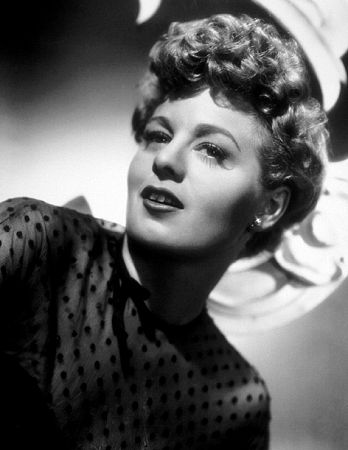Biographie
Shelley Winters was born Shirley Schrift of very humble beginnings on August 18, 1920 (some sources list 1922) in East St. Louis, Illinois. Her mother, Rose (Winter), was born in Missouri, to Austrian Jewish parents, and her father, Jonas Schrift, was an Austrian Jewish immigrant. Her father moved the family to Brooklyn when she was still young so that he, a tailor’s cutter, could find steadier work closer to the city’s garment industry. An unfailing interest in acting occurred quite early for Shelley and she appeared in high school plays. By her mid-to-late teens she had already been employed as a Woolworth’s store clerk, model, borscht belt vaudevillian and nightclub chorine, all in order to pay for her acting classes. During a nationwide search in 1939 for GWTW’s Scarlett O’Hara, Shelley was advised by auditioning director George Cukor to get acting lessons, which she did. Apprenticing in summer stock, she made her Broadway debut in the short-lived comedy “The Night Before Christmas” in 1941 and followed it with the operetta “Rosalinda” (1942) initially billing herself in both shows as Shelley Winter (without the “s”). Within a short time, Shelley pushed ahead for a career out west. Hollywood proved to be a tough road. Toiling in bit roles for years, many of her scenes were excised altogether during her early days. Obscurely used in such movies as What a Woman (1943), The Racket Man (1944), Cover Girl (1944) and Tonight and Every Night (1945), her breakthrough did not occur until 1947, and it happened on both the stage and big screen. Not only did she win the replacement role of Ado Annie Carnes in “Oklahoma!” on Broadway but, around the same time, scored excellent notices on film as the party girl waitress who ends up a victim of deranged strangler (and Oscar winner) Ronald Colman in the critically-hailed A Double Life (1947) directed by Cukor. From this moment, a somewhat earthy film stardom was to be hers playing second-lead broads who often met untimely ends (as in Cry of the City (1948) and The Great Gatsby (1949)), or tawdry-black-stockinged and feather-boa-adorned leads, as in South Sea Sinner (1950) in which her eclectic co-stars included Macdonald Carey and Liberace! As a tarnished glamour girl and symbol of working class vulgarity in Hollywood, Shelley was about to be written off in pictures altogether when one of her finest movie roles arrived on her front porch. Her best hard luck girl storyboard showed up in the form of depressed, frumpy-looking Alice Tripp, a factory girl seduced and abandoned by wanderlust Montgomery Clift in A Place in the Sun (1951). Favoring gorgeous society girl Elizabeth Taylor who is totally out of his league, Clift is subsequently blackmailed by Winters’ pathetic (and now pregnant) character into marrying her. For her desperate efforts, she is purposely drowned by Clift after he tips their canoe. The role, which garnered Shelley her first Oscar nomination, finally plucked her out of the sordid starlet pool she was treading and into the ranks of serious femme star contenders. But not for long. The Brooklyn-bred Shelley just couldn’t escape the lurid bottle-blonde quality she instilled in her characters. During what should have been her peak time in films were a host of badly-scripted “B” films. The obvious, two-dimensional chorines, barflies, floozies and gold diggers she played in Behave Yourself! (1951), Frenchie (1950), Phone Call from a Stranger (1952), Playgirl (1954) and Mambo (1954), the latter of which co-starred second husband Vittorio Gassman, pretty much said it all. Shelley grew extremely disenchanted and decided to return to dramatic study. Earning membership into the famed Actor’s Studio, she went to Broadway and earned kudos, thereby reestablishing her reputation as a strong actress with the drug-themed play “A Hatful of Rain” (1955). Co-starring in the show was the up-and-coming hunk Anthony Franciosa, whom she took as her third husband in 1957. Shelley’s renewed dedication to pursuing quality work was shown by her appearances in a number of heavyweight theater roles including Blanche in “A Streetcar Named Desire” (1955). In later years, the Actors Studio enthusiast became one of its most respected coaches, shaping up a number of today’s fine talent with the Strasberg “method” technique. By the late 1950s Shelley had started growing in girth and wisely eased into colorful character supports. The switch paid off. After a sterling performance as the ill-fated wife of sadistic killer Robert Mitchum in Charles Laughton’s The Night of the Hunter (1955), she scored big in the Oscar department when she won “Best Supporting Actress” for her shrill and hypertensive role of Mrs. Van Daan in The Diary of Anne Frank (1959). From this period sprouted a host of revoltingly bad mamas, blowsy matrons, and trashy madams in such film fare as Lolita (1962), The Chapman Report (1962), The Balcony (1963) Wives and Lovers (1963), and A House Is Not a Home (1964). She topped things off as the abusive prostitute mom in A Patch of Blue (1965) who was not above pimping her own blind daughter (the late Elizabeth Hartman) for household money. The actress managed to place a second Oscar on her mantle for this riveting support work. With advancing age and increasing size, Shelley found a comfortable niche in the harping Jewish wife/mother category with loud, flashy, unsubtle roles in Enter Laughing (1967), Next Stop, Greenwich Village (1976) and, most notably, The Poseidon Adventure (1972). She earned another Oscar nomination for “Poseidon” while portraying her third drowning victim. At around the same time, she scored quite well as the indomitable Marx Brothers’ mama in “Minnie’s Boys” on Broadway in 1970. In the 1970s and 1980s, Shelley developed into an oddly-distracted personality on TV, making countless talk show appearances and becoming quite the raconteur and incessant name dropper with her juicy Hollywood behind-the-scenes tales. Candid would be an understatement when she published two scintillating tell-all autobiographies that reached the best seller’s list. “Shelley, Also Known as Shirley” (1981) and “Shelley II: The Middle of My Century” (1989) detailed her notorious dalliances with such famous movie stars as Errol Flynn, Burt Lancaster, Marlon Brando, William Holden, Sean Connery and Clark Gable, to name a few. Thrice divorced (her first husband was a WWII captain, while her only child, Vittoria, came from her second union to Italian stallion Gassman), Shelley remained footloose and fancy free after finally breaking it off with the volatile Franciosa in 1960. Her stormy marriages and notorious affairs, not to mention her ambitious forays into politics and feminist causes, kept her name alive for decades. She worked in films until the beginning of the millennium, her last film being the easily-dismissed Italian feature La bomba (1999). She also enjoyed Emmy-winning TV work and had the recurring role of Roseanne Barr’s tell-it-like-it-is grandmother on the comedienne’s self-named sitcom. Shelley’s last years were marred by failing health and, for the most part, she was confined to a wheelchair. Suffering a heart attack in October of 2005, she died in a Beverly Hills nursing home of heart failure on January 14, 2006. It was reported that only hours earlier on her deathbed she had entered into a “spiritual” union with her longtime companion of 19 years, Gerry McFord. Gregarious, brazen, ambitious and completely unpredictable — that would be Shelley Winters, the storyteller, whose amazing career lasted over six colorful decades.
Filmographie
-
Nom du film
Evaluations
-
Delta Force (1986)
Action, Aventure, Guerre



